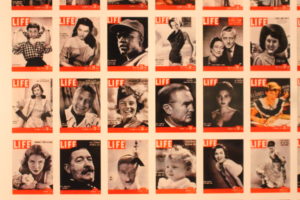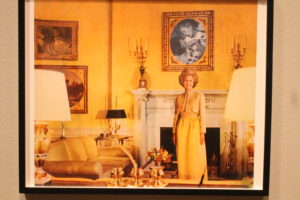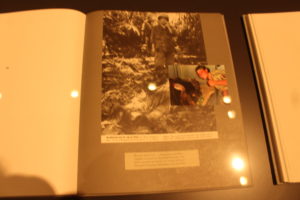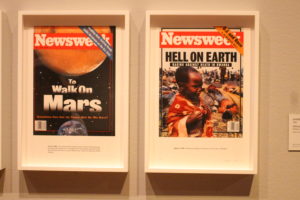Review: Getty Center exhibit sheds light on the dark side of news
The Getty Museum will be closing its “Breaking News: Turning the Lens on Mass Media” exhibit at the Getty Center in Westwood at the end of April. Artists’ works in many different media were on display. The title of the exhibition must be a play on words because nearly every piece took a critical if not cynical view of various news media. The works span the twentieth century with focus paid to large news events like the Vietnam War and the “War on Terror.” In the museum’s description of the show, a quote by Marshal McLuhan, “Media is the message” is offered as a guiding theme for the program. While there were several parallels between the many artists’ criticism of news media, there couldn’t possibly be an overall thesis. There were no artists who celebrated the often over praised work of American journalists.

In Alfredo Jaar’s Searching for Africa in LIFE (1996) he collages ever LIFE cover from 1936 to 1996 to highlight the magazine’s absence of diversity.
I listened to an audio tour of the exhibit and took copious notes of each artist’s work. I watched the extensive video works they had on a looped display. I read every description they had posted around the joint. In short, I drank it in. Overall, the offerings had a macabre and dystopian feel. One can’t help but make connections between the artists’ dark look at media and politics and our current political atmosphere, which often feels dystopian itself. Dec 20, 2016 was the opening date for the exhibition. According to the Getty’s press releases, the opening was announced on Dec 7, almost one month to the day after the Presidential election. I am sure the exhibitors were attempting a way to react to the consequences of Donald Trump’s election and the role the media had played in it.
The show did have moments of levity as well. In a video screening of the Dictator (1978) David Lamelas and Hildegard Duane play a fictional dictator, exiled President Riccardo Garcia Perez of Santa Ana, and TV news reporter, Barbara Lopez, respectively. Barbara Lopez asks Perez about why he has chosen to live out his political exile in Los Angeles. He says, “I could not think of any other place in the world where politics seems so irrelevant.” She later prods him with a curveball, “Could it be a coincidence—five wives, five women, five deaths in fifteen years?” Perez replies with slight hesitation, “Well, they uh, it was God’s wish that they should rest in peace by now.” The most salient point of his piece was when Barbara Lopez asks, “So, I think in our country Watergate has shown that a press can be independent, powerful and incisive.” Dictator Perez responds, “Uh, uh, wouldn’t be so sure about it. Don’t forget that the medias[sic] in this country are a big source of power and without a doubt are strong economic interest.” Well put, Mr. Dictator.
In another humorous posting, Sarah Charlesworth cut out the text of 1978 newspaper front pages around the world, leaving only a masthead and photographs. It gives the viewer a quick and relatable meaning of the newspapers focus. She then posted a dozen or so front pages from L’Osservatore Romano, the Vatican’s semi-official newspaper. What is quite amusing about this exhibit is that while news around the world focused on big events like tragedies, crimes or elections, L’Osservatore Romano mostly followed the happenings of the pope in his traditional, whimsical garb. One can only speculate as to the actual headlines above these papal photos, but I suspect something along the lines of, “Lookin’ Good, Mr. Dictator!”
In Omer Fast’s CNN Concatenated he cuts together television news clips of various broadcasters saying individual words. The result is a terrifying poetry to the shallowness and materialism of the current media and the subconscious insecurities that drive them. Several broadcasters confess to us, “I’ve done hurtful things. We thrive on consuming each other.”

First Lady “Pat” Nixon Posing in the Yellow Oval Room of the White House. Martha Rosler has inserted the cutout of a dead young woman.
There were several news mosaics at the show. The foyer was plastered with clippings of Television screen shots put together by artist, Donald Blumberg. In the description, Blumberg said that when he was watching images on television from the 1960s of Lyndon Johnson, Richard Nixon, George Wallace and the Vietnam War he felt he was witnessing history in the making. Blumberg’s print mosaics were quite reminiscent of Andy Warhol’s colorized prints of Marilyn Monroe. One of the descriptions of Blumberg’s prints said he even used repetition to dull the meaning of the image of the male leaders he printed. This is exactly the same intent behind much of Warhol’s work as well. Warhol attacked our notion of celebrity with repetition. Blumberg goes after leadership. Blumberg is quoted as saying, “The images were made to fix the period, to fix the trauma. They are intended for people not to forget.” Indeed, trauma would be well-fixed in the viewer’s mind after this exhibition.

Specialist Sabrina Harman posing over a decayed Iraqi corpse.
Among the impressions most emblazoned in my mind after the show, was one of First Lady, Pat Nixon by Martha Rosler’s recent collages called “Bringing the War Home.” The title may be a nod to the post-traumatic stress syndrome common among returning veterans, which was beginning to be understood in medical and psychological terms after the Vietnam War. Rosler cut out an image of a shot up Vietnamese girl and pasted it in a picture frame in the White House. The result is a pleasant and subdued First Lady “Pat” Nixon posing in front of the shot up corpse of a girl within the stately executive mansion. Wow. It reminds me of a later photo shown in the exhibit posted by Adam Broomberg and Oliver Chanarin of a beautiful young lady soldier of the Iraq War posing in her military outfit with a beaming smile giving the thumbs up to what looks like the charred corpse of a dead Iraqi. The image sears into memory much like the flesh of that poor, benighted insurgent. Broomberg and Chanarin pasted photos of the ‘War on Terror’ above the World War II poems of Bertolt Brecht, who had in originally posted his horrifying photos of that war.
The poems are at moments mesmerizing set beneath the horror of war. Beneath a photo of the burning World Trade Center, I paused on the lines, “A cloud of smoke told us they were here. They were the sons of fire, not of the light.” “Sons of fire, indeed,” the insurgent whispered beyond the grave.
Perhaps the most moving part of the showcase was Alfredo Jaar’s Untitled (Newsweek), 1995,in which he posts Newsweek magazine covers as the Rwandan genocide unfolded. Newsweek covers may not be the best measure of the focus of the American press, but Jaar’s message of American media’s insular reporting is sharply felt. The viewer takes in the near high
jinks of the magazine’s publishers and then must digest the ghastly number of bodies literally piling up simultaneously.

The conclusion of Alfredo Jaar’s Untitled (Newsweek).
When I returned outside to the gleaming white Greco-Roman modernist beauty of the Getty’s architecture, I felt the lingering gloom of the exhibit. I suppose that is the response great art should induce. But not even a scenic walk back to my car could shake the feeling. It probably didn’t help that I had Jeremy Scahill’s latest news venture, a podcast called “Intercepted,” playing in my earbuds. The exhibit had set its hooks in deep. We reenter an uncertain world with the possibility of a bleak and inescapable future.



